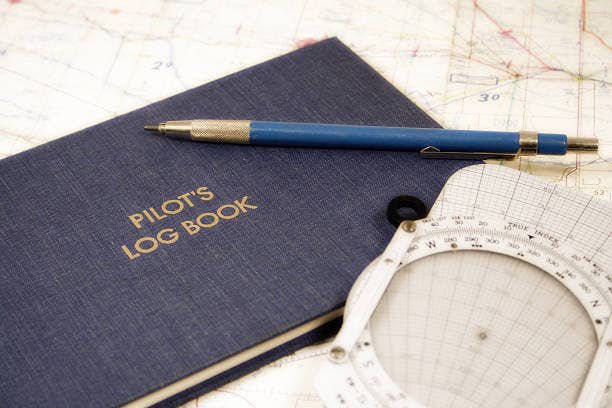When Planning Your Aviation Year Ahead, Don’t Just Wing It
Here are nine ideas for adding hours to your logbook in 2025.

For pilots with the annual total in their logbook, the start of a new year can be a great time to make a plan. [Credit: iStock]
For many pilots, the closing out of a year comes with it a New Year's resolution to fly more often. In the aviation world, it's common, especially when pilots review their logbooks and find disappointment with the annual total.
For pilots seeking a larger end-of-the-year number next time around, the start of a new year can be a great time to make a plan. Here are nine ideas to help add hours to your logbook in 2025.
1. Identify What Kept You Out of the Air This Year
Did life get in the way? Was it a financial thing? Was there a shortage of airplanes? Until you identify what kept you out of the airplane, you can't make a plan to mitigate it. If it was a life thing, has the situation been resolved, or is there a workaround? For example, if Saturday mornings used to be the day for the fly-out breakfast, but now it's junior's soccer practice, can you move the flight to another day or time?
If it was finances, do you have the resources to budget for X-number of flight hours per month and stick with it?
If it was a lack of airplanes, have you identified different places to rent, got on the waiting list if the flight school has one for student pilots, reached out to a flying club, or looked into the possibility of an airplane partnership? These could be a long shot, but if you don't ask, the answer will always be no.
2. Make a List of Aviation Goals
It doesn't have to be a specific rating or certificate. Just make sure they add to your aviation skill set. Some examples might be: "This year I will get my complex endorsement," "This year I will do my flight review in a tailwheel aircraft," "This year I will put 25 hours of cross-country time in my logbook," or "This year I will practice instrument flying at least once a month."
Don’t be afraid to plan that big flight—from Maine to California, or from anywhere to Oshkosh. Start early for best results.
3. Be Realistic
When you begin your flying career, it's common to want to fly every day with the intent of being an airline pilot within a year. Very rarely does this happen, but as a fledgling pilot you don't know what you don't know.
Learning to fly requires muscle memory and knowledge, and time to fly. Lessons are usually a few times a week for two to three hours at a time with approximately 1.0 to 1.5 hours in the air. Also required is time between lessons to absorb what you learned—and the big one, money. It is not uncommon to spend $6,000 or more for a private pilot certificate.
You will likely be paying for an airplane rental and the services of a flight instructor if you rent from a flight school. Please keep in mind that you will be competing with other students for the instructors and airplanes. The schedule may shift around, therefore your flying may be inconsistent.
4. Plan to Maximize Best Weather Windows
Your CFI cannot control the weather. When you get the resources in place to begin flying lessons in a particular month, aim for the one with the best VFR weather.
Plan to fly at least twice a week, although three times is better until first solo. Then cut it back to twice a week if you need to.
If you are building cross-country hours toward your instrument rating under Part 61, find another private pilot and share expenses and flight time on cross-country flights. Make a plan to fly X-number of times a month for X-number of hours.
5. Commit to Ground Study
If there is a knowledge test in your future, commit to studying at least four to five hours a week to prepare. Find a study app that allows you to go through questions and answers, and that offers explanations as to why an answer is correct.
If you are in need of a flight review, when you do the ground study make a list of areas where your knowledge is soft. Schedule a face-to-face refresher with the CFI. Pay special attention to airspace in your area because it can change. The floor of the Class B that used to be at 1,900 feet may have dropped down to 1,700 feet since the last time you flew, or an airport's common traffic advisory frequency (CTAF) may have changed. Study the sectional carefully, and note the changes.
6. Get on the Schedule
Most flight schools and CFIs are busy, so go ahead and make the call to get on their schedule, even if it is a few months out. For example, if you will need a flight review in March, get on the schedule for January/February now. These days most flight schools are so busy they are booked out at least a few weeks. Don't procrastinate about this because those weeks can slip away.
7. Be Specific About Training Expectations
When you make the appointment with the flight school or CFI, be clear about your expectations.
"This is a proficiency flight." "This is a recurrency flight." "I want to resume the training for my instrument rating." "I want to get my complex/high performance endorsement." "I want to learn how to use the G1000." Be specific. Be firm.
It can be very frustrating to get to the airport and find yourself paired up with a CFI who doesn't have the experience or qualifications to do the flight or to find out you have been put in an airplane that isn't appropriate to the experience you seek. For example, being put in the Cessna 150 round dial when you wanted the G1000 Cessna 182.
8. Establish a Study Schedule
A good pilot doesn't stop studying after they pass the knowledge test. Commit to a review of aviation knowledge every week. It can be as simple as taking an online quiz from an aviation organization that pops up in your email or using an app to review subjects like airspace and FARs with the swipe of a finger.
9. Establish 90-Day Goals
Smaller goals help us reach the big goals. For the pilot who already has a certificate, focus on doing 10 takeoffs and landings, or flying six instrument approaches in the 90 days, or adding at least three cross-country flights to the logbook.
Adjust the goals to meet your needs. For example, you may just want to go out and practice radio calls in the pattern, or pick up flight following.
Follow these tips and by the end of 2025, you'll be impressed by your accomplishments.

Sign-up for newsletters & special offers!
Get the latest FLYING stories & special offers delivered directly to your inbox






